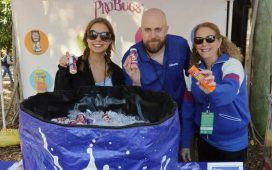![]()
Chris Hadfield’s performance of David Bowie’s Space Oddity on the ISS enraptured tens of millions of viewers (Image: Chris Hadfield / YouTube)
Veteran astronaut Chris Hadfield has what you might call a healthy relationship with fear. Put simply, the only man to perform David Bowie live in orbit, of which more shortly, doesn’t believe in it.
Not surprising, perhaps, for someone who had his fillings drilled out and has spent more time than he cares to recall strapped into a centrifuge and spun at eye-poppingly high speeds to prepare him for space travel.
In fact, as he explains, just six months of his 21-year career as an astronaut actually took him off the planet in three missions.
“So I spent 20-and-a-half years getting ready and supporting other people getting ready,” he says. “That’s very much the life of an astronaut – doing the work to be able to then go do the thing you’re training for.
“In combat flying and test flying, things occasionally happened that I had to dig really deep to be able to deal with. F-18 fighter jets going out of control, significant flight control system malfunctions, near mid-air collisions. But I didn’t just get plonked into a cockpit and count on my innate ability to do things, I trained for years.”
Surely, though, there must have been moments of truly bottom-clenching terror, secured in a tiny capsule for instance atop some of the most powerful man-made contraptions ever, hurtling free of Earth’s bounds at unimaginable velocities?
“The most dangerous thing I’ve ever done is fly a rocket ship,” he concedes. “Danger per second, nothing matches it. And I was hugely respectful of it, extremely excited and involved… but I wasn’t fearful of it.”
Needless to say, the 65-year-old is exactly the kind of man you’d want on your side in a crisis.
But such stoicism can be sobering for us ordinary humans, who spend our entire lives somewhere on the spectrum between mild anxiety and downright fear over everything from missing our bus to losing our jobs to dying.
![]()
Singer David Bowie always wanted to go into orbit and loved Hadfield’s cover of Space Oddity (Image: Getty Images)
“Heck, almost 40,000 people die in car crashes in the United States every year,” Hadfield continues. “And yet every single day people get into cars. So everything worth doing in life has risk. The real question is, ‘Why are you taking that risk and have you done all the work?’”
Supremely articulate, and imbued with a passion that fairly crackles over the Zoom link from his family home in Florida, the Canadian ex-military and test pilot will be asking – and answering – such questions on a major UK tour next year. He’ll also be talking about his extraordinary life and career and revealing never-before-seen space images. But I suspect one question will dominate: how he came to perform David Bowie’s 1969 single, Space Oddity, approximately 250 miles up and orbiting the planet while commanding the International Space Station in 2013?
Fortunately it’s a story Hadfield is happy to share time and again.
“I’ve been a musician my whole life and the NASA psychiatrists put a guitar on the ISS because they recognised music is an art necessary for human mental health,” he explains.
“So I knew I’d be playing music up there. And I wrote and recorded an entire album of music while I was on the ISS.
“I did it when I was supposed to be asleep. I floated a microphone in front of me and played that guitar and taught myself to use [music app] GarageBand late at night and recorded multiple tracks. And then we mixed it all on the ground.
“Space Oddity was my son Evan’s idea. At first, I balked because I’d never played it before and trying to cover Bowies is like, ‘Yeah, sure, next I’ll cover Bach!’ But when I sang it, I was taken by how well Bowie predicted it was going to feel to be on a spaceship. I don’t know how he did it, but it really captured my emotions: ‘Here am I, floating in a tin can, far above the world.’
“So I recorded the vocal track and then I got the guitar track underneath and some other musicians on Earth finished it off.”
![]()
The International Space Station in Orbit over the Earth (Image: NASA/Roscosmos)
And that would have been it – but Evan, a documentary maker, told his father he needed to make a video or no one would ever believe him. “I’m like, ‘S***, I’m busy. I’m commanding a space station.’ But one afternoon for about an hour, I just played and sang along with myself then sent down all those video clips. And Evan put it together with a buddy.”Hundreds of millions of people have now enjoyed the footage of Hadfield floating free while performing the iconic track – and even the song’s creator, who died aged 69 in 2016, was “super complimentary”.
“Bowie always wanted to fly in space. It’s a huge recurring theme in his music and he wrote Space Oddity when he was 19 turning 20. So he loved that this song he’d written as a teenager was being performed in a place he’d always dreamed of,” notes Hadfield.
We’re talking shortly after Donald Trump’s US election win and I wonder how he feels the 47th and next President will view space.
“If you look at what he did in his last administration, he was quite supportive of space. And he’s enlisted one of the leading figures in world space capability with Elon Musk. But it remains to be seen.”
Hadfield believes space continues to fascinate because of the “human necessity” to explore. “If you look at how evolution has developed us, it’s given us the ability to walk at least a year before it’s given us the ability to talk, which is funny when you think about it,” he says. “No one can explain anything to you, yet you have the mobility to go explore. To me, it’s very clear evidence we are inveterate and undeniable explorers.
“The eternity of the universe is right there, laid out before us, and yet until very recently we couldn’t touch it. But within my lifetime, we’ve gone from no one having ever flown in space to Yuri Gagarin and Alan Shepard and people walking on the Moon and now people living and working in space.”
Born in Ontario in 1959 and raised on a farm, Hadfield’s own interest in space was sparked by comic books and then science fiction, including Star Trek and 2001: A Space Odyssey. “If I’d grown up in the 1940s, it would have fizzled out there. But because it was the 60s and early 70s, people were actually starting to do it. It was that link between a fantastical idea of what might be possible and the actual practical application.
![]()
A SpaceX Heavy Booster is grabbed by ‘chopsticks’ at the launch pad in Texas in October (Image: AFP via Getty Images)
“That’s what really turned my head and so, on July 20, 1969, when Neil Armstrong and Buzz Aldrin walked on the Moon, I was just about to turn 10 and thought, ‘That is the coolest thing going on in all of humanity. I want to be a part of that.’”
Today Hadfield describes his nine-year-old self as the “puppet master” still directing his actions. Having learned to fly a glider at 15, a light aircraft at 16, he enlisted in the Canadian Armed Forces and earned an engineering degree. During a 25-year service career, he flew military jets during the Cold War, intercepting Soviet bombers practising missile runs against North America, later becoming a test pilot.
“All told, I’ve flown about 100 different types of airplanes,” he tells me.
Then the call finally came to join the Canadian astronaut programme.
“I’ve always had the very clear first thought of, ‘If somehow I can manage it, I want to have spaceflight as an important part of my life’,” he explains.
“All the other decisions I’ve made and the careers I’ve chosen have been on a potential path that might help. So one Saturday afternoon, after an extremely gruelling and unsettling six-month selection process, the president of the Canadian Space Agency called and asked, ‘Would you like to be one of Canada’s astronauts?’ It was the call I’d been waiting for since I was nine.
“My wife Helene and I were in a high school play together. She was just turning 15 and I was 16, and we’ve been together our entire lives. So she wasn’t surprised because it had always been part of my dreams.”
Hadfield believes humanity is, today, transitioning from “bewildered onlookers to actual participants in the exploration and understanding” of the universe.
“If you look at the Europa Clipper probe heading out to look for life on the watery moons of Jupiter, or drilling on Mars, or finding 400billion litres of water in the craters of the Moon, it’s taking those little tottering one-year-old legs and giving them wings.”
He watched amazed last month as SpaceX, Elon Musk’s company, captured a used Super Heavy Booster rocket in mechanical arms, dubbed “chopsticks”. He compares it to the first Wright Brothers flight or the first Ford Model T car.
![]()
Canadian ex-astronaut Chris Hadfield is touring the UK next year to talk about his extraordinary life (Image: Birmingham Mail)
“This is a technology that’s similarly going to change everything as far as human transportation goes,” he says. “It was only the fifth flight, and it does something right on the edge of miraculous. Now you check it out, fill it up with fuel, learn from it and then launch it again.
“That’s a huge step forward, to having a 100% reusable spaceship, twice as powerful as the Apollo rocket. It’s also another part of what I’m going to talk about on my tour.
“Yes, there’s lots of bad human behaviour around the world. But there’s also some pretty legendary, historic, cool, technologically-advanced things happening. And it’s worth noticing them.”
Hadfield, also a bestselling author whose 2021 thriller, The Apollo Murders, is being made into a TV series, thinks we’ll return to Moon orbit next year or shortly afterwards and be on its surface laying the grounds for a permanent settlement by 2030.
“At times, especially when things are dark and black, you need some ‘Hey, we’re also capable of doing this,’” he adds. “Remember, I was that Cold War fighter pilot and yet, eight years later, I helped build the Russian space station Mir, and learned to speak the language.
“So the pendulum swings and it’s up to us to find ways to work hard on the quality of human life globally.”
Chris Hadfield: A Journey Into The Cosmos, UK & Ireland Tour, takes place in June 2025. Tickets are available now via: Fane.co.uk/chris-hadfield










